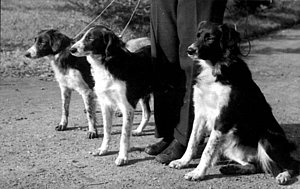Compared to the long period of time shepherds use dogs for working at the farm, the Border Collie as we know him is quite young.
In the nineteenth century we can find several publications in which dogs with the description 'Collie' or 'Colley' are mentioned. Illustrations dating from this time show a varying exterior. Sometimes the dogs look more like the current Scottish shepherd, in other cases they look like the Border Collie, and sometimes it is impossible to recognise a current breed.
At the end of the nineteenth century, you can find a type of 'Colley' that resembles the current Border Collie a lot. With the birth of the legendary Old Hemp in 1893 and Old Kep in 1901, the current Border Collie type has emerged. More about these dogs in the chapter 'The Ancestors'.
The name Border Collie
There is a lot of dispute about the origin of the name Border Collie. According to Gosset1) the origin of the word Collie lies in the word 'Coal'; 'colley' or 'coly' in the English language is related to the colour black.
Combe2) on the other hand thinks Collie is a Gaelic word with the meaning 'useful'. In her book she furthermore argues that stories stating that the Border Collie was named after the sheep breed the dogs worked, cannot be confirmed. Nowhere a sheep breed with the name 'colley' or 'coally' can be found.
Another theory takes it yet one step further and relates the word 'collie' to the German 'Kuli'. 'Kuli' is pronounced the same way as the English 'coollie' which means 'worker'. The fact that there is indeed a breed called 'Alt Deutscher Kuli' which works with sheep, makes the story complete. This word 'Kuli' is supposedly coming from 'collaborare' (to collaborate) in Latin. At the time of the Roman occupation, the Gaelic provinces bordered at the Rhine in Germany.
The word Border can be attributed to James Reid—secretary of the International Sheepdog Society (ISDS) from 1915 till 1948. In 1918 he described the winner of the Supreme Championship as Border Collie. It took till 1946 before he mentioned the name Border Collie on the ISDS registration papers.
The first trials
Often, working dogs where compared to each other, but most of the time not beyond the village borders. Therefore a lot of dogs where considered to be excellent shepherds.
This changed at 9 October 1873. At a field in Bala (Wales) the first official trial was organised by Richard John Lloyd Price. This first trial was won by James Thompson with Tweed, a black and tan dog of Scottish origin (just like Thompson). Ten dogs competed in the Bala trial, and the event drew some 300 spectators. Interesting detail is that a friend of RJ Lloyd Price—SE Shirley—founded the Kennel Club in the same year. This Kennel Club took care of the pedigree of the Border Collie.
In other parts of the United Kingdom more trials followed fast: Scotland 1874 and England 1876 (Northumberland). The first English trial winner was Walter Telfer, brother of Adam Telfer, who was the breeder of Old Hemp.
In July 1906 the ISDS was founded by twelve top-handlers because of their dissatisfaction with the Kennel Club. In their opinion, the Kennel Club was more focussed on the exterior than the ability to work.
1) GOSSET, Adelaide L.J.; The Shepherds of Brittain: Scenes from a Shepherd's Life. Constable and Company Ltd.; London.
2) COMBE, Iris; Herding Dogs: Their Origins and Development in Britain; Fabar and Faber; London
© 1998-2024 Nice of you to Come Bye
